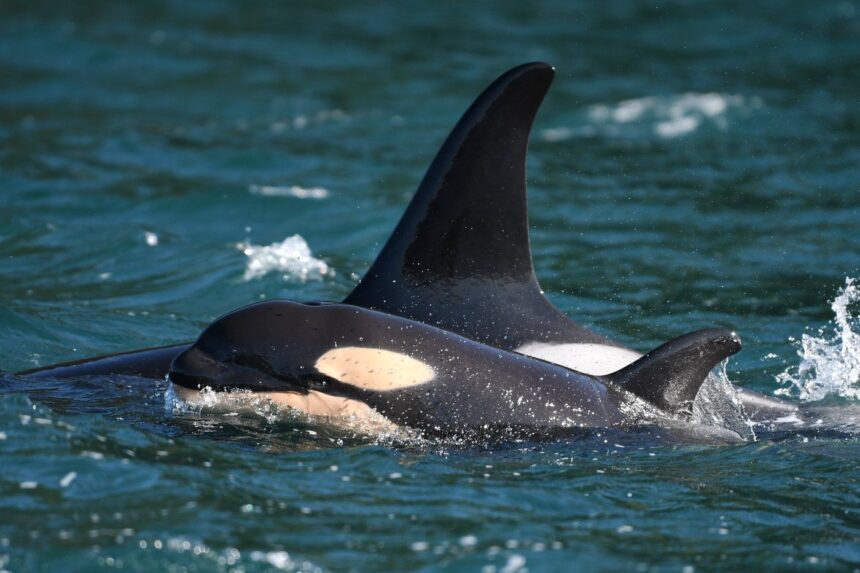I watched the pod surface in unison, their sleek black dorsal fins cutting through the fog like shadows from another world. Six orcas, including a calf that couldn’t have been more than a year old, moved with a synchronicity that felt almost like a shared consciousness. It was my third day on a research vessel tracking the endangered Southern Resident killer whales off Vancouver Island, and despite years covering environmental stories, I still felt my breath catch at their presence.
“These are the same individuals J-Pod lost last summer,” whispered Dr. Misty MacDuffee, a biologist with Raincoast Conservation Foundation who has studied these waters for over two decades. “We’re down to just 74 animals now.”
The Southern Resident killer whales, culturally and biologically distinct from other orca populations, face a precarious future. Once numbering more than 200 individuals, this unique community of orcas has declined dramatically since the 1960s, with population numbers hovering at critical levels. These orcas are the only killer whale population listed as endangered under both Canadian and American endangered species legislation.
Yesterday, an international group of 36 marine scientists published an open letter demanding immediate action from the Canadian government to protect these iconic mammals. The letter, addressed to Fisheries and Oceans Canada, calls for expanded critical habitat protection, stricter vessel regulations, and most controversially, emergency fishing closures in key feeding areas.
“We’re beyond the point of small measures,” said Dr. Lance Barrett-Lennard, director of the Marine Mammal Research Program at Ocean Wise. “These animals are literally starving in what should be their richest feeding grounds.”
Unlike the mammal-eating Bigg’s killer whales whose populations are increasing along the coast, Southern Residents feed almost exclusively on Chinook salmon, particularly from the Fraser River. Chinook populations have declined by over 60 percent since the 1980s, according to Fisheries and Oceans Canada’s most recent stock assessment.
The scientists’ letter points to three critical factors threatening the orcas’ survival: food scarcity, underwater noise pollution, and toxic contamination in coastal waters. Of these, food shortage remains the most immediate threat.
Standing on the rain-slicked deck, MacDuffee pointed toward a map showing historical salmon runs. “Before European settlement, we estimate the Fraser River alone produced between 30 and 60 million salmon annually,” she explained. “Today, we’re looking at less than 2 million, with Chinook at just a fraction of that.”
For the coastal First Nations who have coexisted with these whales for thousands of years, the crisis reflects a deeper imbalance. Laich-kwil-tach marine steward Gina Thomas invited me to her community on Quadra Island last month, where she described the cultural and spiritual significance of the killer whales her people call “qolǝs.”
“When we talk about these relatives disappearing, we’re not just talking about biodiversity loss,” Thomas told me as we watched the sun set over the Salish Sea. “We’re talking about the unraveling of relationships that have defined this coast since time immemorial.”
The Laich-kwil-tach and other coastal Nations have been calling for stronger protections for decades, combining traditional ecological knowledge with contemporary conservation efforts. Their recommendations align closely with those in the scientists’ letter.
Vessel noise presents another significant challenge. Southern Resident killer whales use echolocation to hunt, but underwater noise from ships, ferries, and whale-watching vessels can mask the subtle clicks they use to locate prey.
“It’s like trying to find food in a crowded, noisy restaurant where you can’t see and can only locate your meal by listening,” explained Dr. Valeria Vergara, a marine mammal acoustics specialist who joined our vessel for the research expedition. “Now imagine someone constantly blaring music right next to your ear.”
In 2019, the federal government implemented interim sanctuary zones restricting vessel traffic in key foraging areas around Saturna and Pender Islands. These measures, while welcomed by conservationists, were criticized for being too limited in scope.
The new scientific consensus calls for expanding these zones and making them permanent, with additional restrictions during critical feeding seasons.
The economic implications of such measures have raised concerns among commercial fishing operations and the whale-watching industry, which generates an estimated $250 million annually for British Columbia’s coastal economy.
“We understand the necessity of protection,” said Sarah Patton, executive director of the Pacific Whale Watch Association, when I interviewed her last week. “But we need solutions that work for both the whales and the communities that depend on these waters.”
Patton’s association has implemented voluntary guidelines that exceed federal requirements, including maintaining greater distances from the endangered orcas and limiting viewing time.
Back on the research vessel, I watched as the pod submerged, disappearing beneath the slate-gray waters. According to tracking data, they had traveled nearly 120 kilometers in the past 24 hours—an unusually long distance that researchers interpret as a sign of increased foraging effort.
“They’re working harder for less food,” MacDuffee said, scrolling through tracking data on her tablet. “And the females are struggling to produce healthy calves in these conditions.”
Female orcas begin reproducing around age 12 and typically bear a calf every five years throughout their reproductive lives. But among Southern Residents, researchers have documented a 69 percent pregnancy failure rate, according to a 2017 study published in PLOS ONE. Scientists attribute this reproductive failure to malnutrition and the mobilization of toxic chemicals stored in the whales’ blubber when they metabolize fat during food shortages.
The federal government’s official recovery strategy, last updated in 2018, acknowledged these threats but has been criticized for implementing measures too slowly. The scientists’ letter calls for the strategy to be updated with more ambitious targets and firm timelines.
When I contacted Fisheries and Oceans Canada for comment, a spokesperson said the department is “reviewing the recommendations and remains committed to Southern Resident killer whale recovery,” noting that an announcement regarding new protection measures is expected in the coming weeks.
As our vessel turned back toward Victoria’s harbor, I thought about something Dr. Barrett-Lennard had told me earlier: “These orcas represent one of the most studied wildlife populations on the planet. We know exactly what they need to survive. The only question is whether we have the collective will to provide it.”
The sun briefly broke through the clouds, illuminating the Salish Sea in silver light. Somewhere beneath those waters, J-Pod continued their endless search for sustenance in waters their ancestors had thrived in for thousands of generations—waters that may, with enough political will and public support, once again become their sanctuary rather than their struggle.






